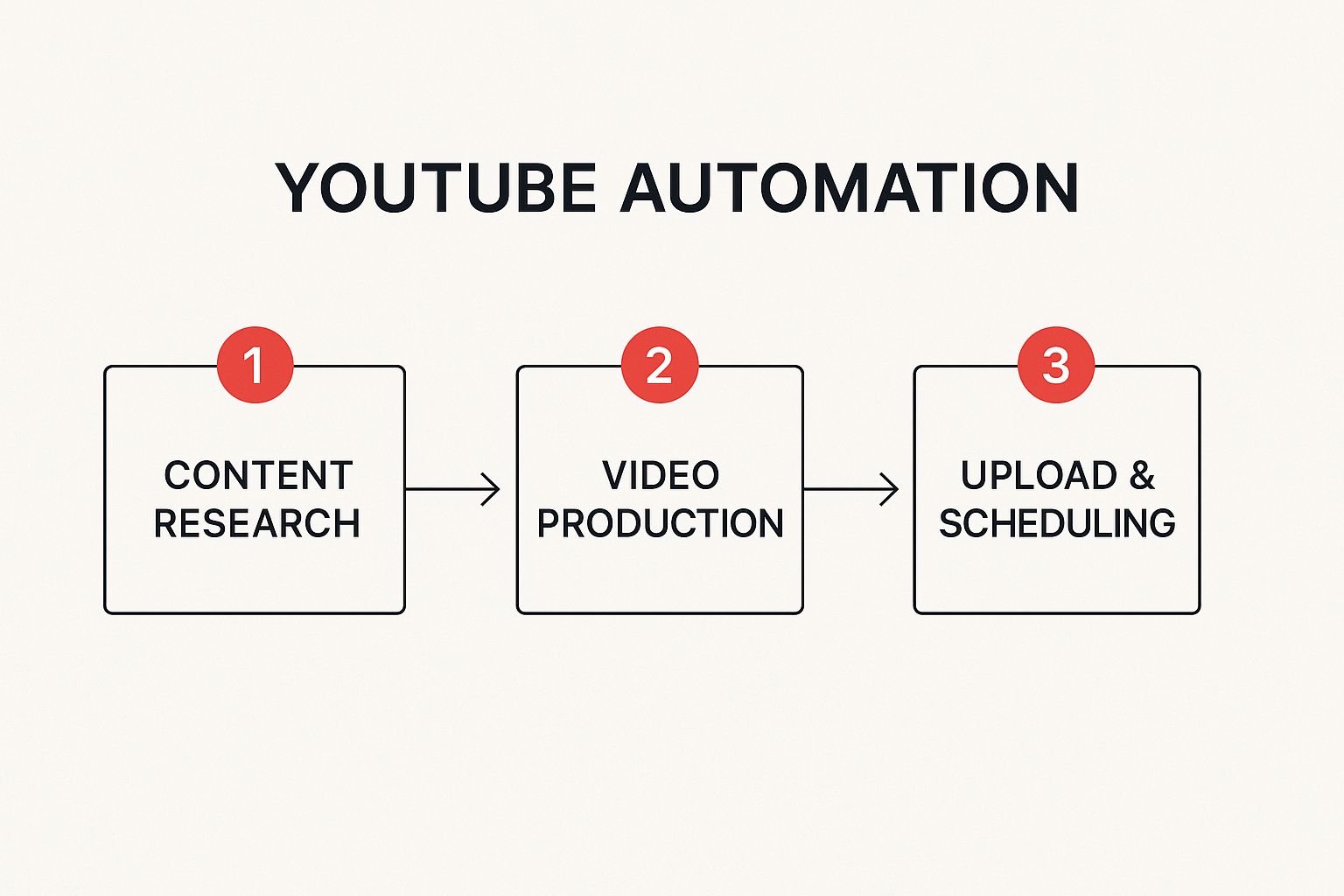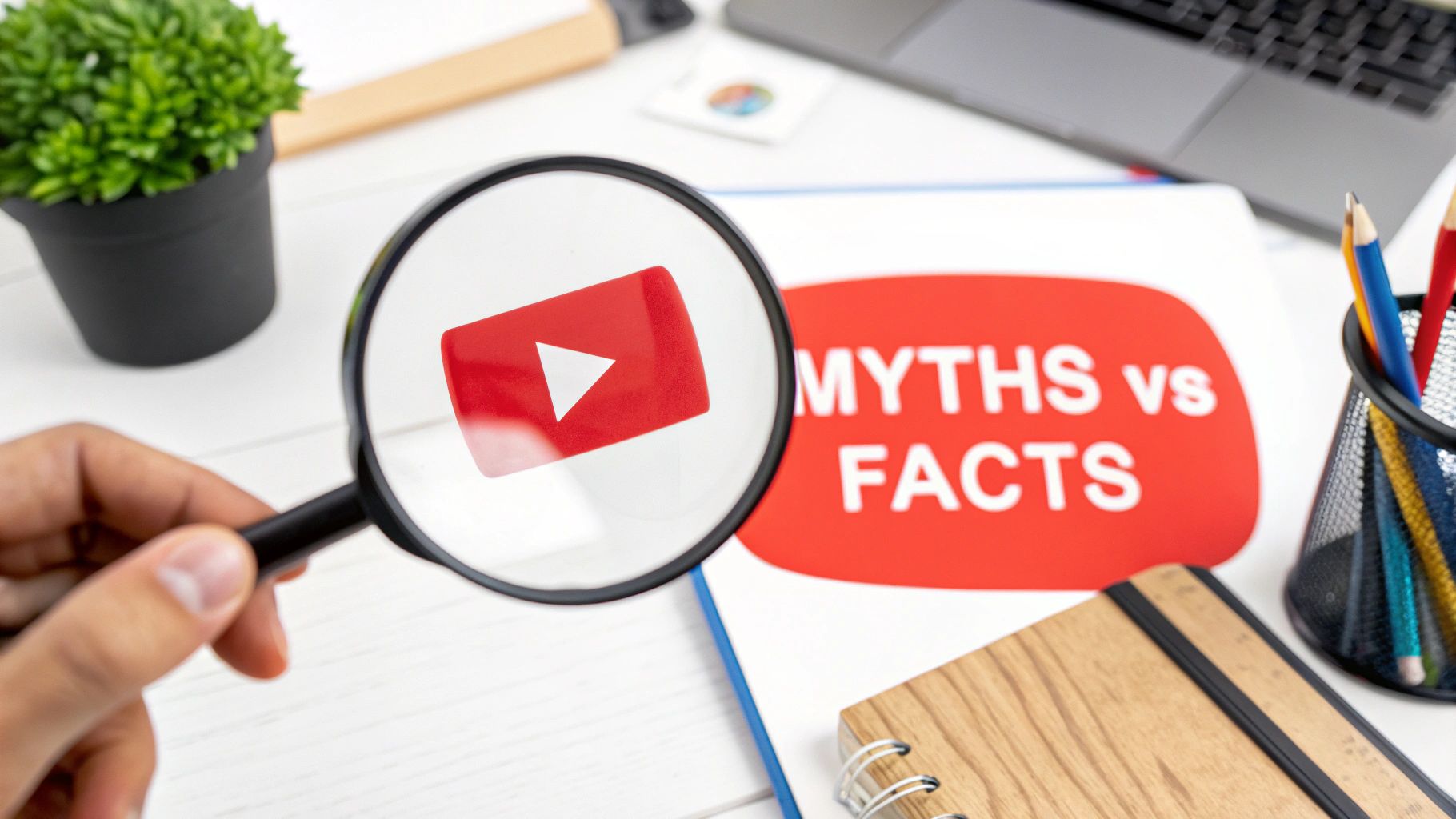Yes, YouTube automation is legit, but let's be crystal clear: it’s not a get-rich-quick scheme or some magic button for passive income. It’s a business model.
Think of it like being a movie producer instead of an actor. You're the one calling the shots, setting the strategy, and managing the team, but you aren't the one in front of the camera for every scene. Legitimate automation is all about building an efficient system to create great content at scale—it's not about spamming YouTube with soulless videos.
What YouTube Automation Really Means

The term "YouTube automation" has gotten a bad rap, often bringing to mind robotic voices and low-effort content designed purely to game the algorithm. While those kinds of channels definitely exist (and almost always fail), that’s not what we're talking about here.
Real YouTube automation is about building a scalable content production line. Instead of being the star of the show, you become the producer, director, and strategist behind it all. Your job shifts from being a personality to being a business owner.
The Business System Analogy
Imagine you own a popular restaurant. You aren't personally cooking every meal, waiting on every table, and washing every dish, right? Of course not. You created the concept, designed the menu, and hired a team of skilled chefs, servers, and managers to bring your vision to life.
That’s exactly how successful YouTube automation works.
You’re the one responsible for the big picture:
- Choosing a profitable niche: This is like deciding your restaurant's cuisine.
- Developing a content strategy: This is your menu and your marketing plan.
- Hiring a team: You find talented scriptwriters, voiceover artists, and video editors (your chefs and staff).
- Overseeing quality control: You make sure every video meets your channel's standards before it goes live.
This systematic approach allows you to produce high-quality videos consistently without getting bogged down in every tiny detail of the creation process. It’s all about smart delegation, not a total absence of work.
The core idea is to remove yourself as the bottleneck in the content creation process. By building a team and a workflow, you can scale production far beyond what one person could ever achieve alone.
And this model works. Channels that get this right often generate significant income, with many earning anywhere from $500 to over $5,000 per month. This systematic approach to the creator economy is part of a market projected to hit around $8.9 billion by 2026. If you want a deeper look, you can discover more insights about YouTube automation salaries and see the data for yourself.
Legit vs. Illegitimate Strategies
The reputation of YouTube automation really comes down to the approach. There's a right way and a wrong way to do it, and the difference is night and day. A legitimate channel focuses on creating real value for an audience, while an illegitimate one relies on spammy tactics that violate YouTube's policies.
Here’s a quick breakdown of what separates a sustainable business from a channel that's doomed to fail.
| Characteristic | Legitimate Approach (Business System) | Illegitimate Approach (Scam) |
|---|---|---|
| Core Goal | Build a long-term brand that provides genuine value to a specific audience. | Trick the algorithm for quick views and revenue with minimal effort. |
| Content Quality | Original scripts, high-quality visuals, and professional voiceovers or editing. | Reused, stolen, or auto-generated content with robotic narration. |
| Team | Skilled freelancers (writers, editors, artists) treated as professional partners. | Low-cost, low-quality services or bots that produce generic output. |
| Audience Focus | Understands viewer needs and creates content that educates, entertains, or solves a problem. | Clicks and views are the only metric; audience engagement and satisfaction are irrelevant. |
| YouTube Policies | Adheres strictly to YouTube's Community Guidelines and monetization policies. | Bends or breaks rules on spam, repetitive content, and reused material. |
| Outcome | Sustainable growth, loyal subscriber base, and a profitable, long-term business. | Channel demonetization, strikes, or complete termination. A short-lived cash grab. |
Ultimately, your success hinges entirely on your commitment to quality and ethical practices. One path leads to a real business, while the other is a fast track to getting your channel shut down.
How an Automated Channel Actually Works
Think of an automated YouTube channel less like a personal diary and more like a small, efficient media company. There's no magic "automate" button. Instead, it's all about a finely-tuned production line where different tasks are handed off to freelancers or sped up with smart tools. The channel owner isn't the one in front of the camera; they're the producer, the big-picture strategist guiding everything from idea to upload.
This system turns the often chaotic process of content creation into something predictable and scalable. You're no longer relying on a single person's inspiration or energy. Instead, you're building a content engine that keeps running, churning out videos consistently, whether you're directly involved in the nitty-gritty work or not.
The entire operation usually follows a few distinct stages. Let's break down what that assembly line looks like.

This workflow shows how a simple idea gets transformed, piece by piece, into a finished video that’s ready for its audience. Every single step is a vital link in the chain.
Stage 1: The Research and Scripting Phase
It all starts with picking a niche and digging deep. The first job is to find video topics that a lot of people are searching for but that don’t have a ton of competition just yet. This is where so many aspiring channels go wrong—they make videos about what they find interesting, not what the data shows viewers are actually watching.
Once a winning topic is locked in, the scriptwriter gets to work. A solid script is the absolute backbone of a great video. Its most important job is to grab the viewer's attention in the first 15 seconds and hold it all the way to the end. That finished script then goes to a voiceover artist to record the narration.
Stage 2: The Video Production Phase
With the audio track ready, the video editor steps up. Their task is to bring the script to life visually. They'll pull from a few different sources to build an engaging video:
- Stock Footage: Sourcing high-quality video clips that match the narration.
- Animations: Creating simple graphics or text effects to highlight key points.
- Images and Graphics: Finding other visuals to keep things interesting and break up the footage.
At the same time, a graphic designer is crafting the perfect thumbnail. This is no small task. The thumbnail is probably the single most important factor in getting someone to click on your video. It has to pop, instantly tell the viewer what the video is about, and stand out in a sea of other thumbnails. You can learn more about finding the right people for this process in our guide on starting an automated YouTube channel.
Stage 3: The Final Polish and Publication
Once the editor is done, the video isn’t quite ready. It first goes through a final quality check. The channel owner or a manager will watch it through to check the pacing, make sure the audio is clear, and ensure the overall look and feel matches the channel's brand.
Finally, it's time to upload. This involves more than just hitting a button. A strategic, keyword-focused title and a detailed description are written, and relevant tags are added to help YouTube's algorithm figure out who to show the video to. The video is then scheduled to go live at the perfect time—right when the target audience is most likely to be online. This complete, end-to-end system is what makes the whole thing work like a well-oiled machine.
Using AI and Modern Tools The Right Way

Artificial intelligence has completely shifted how YouTube automation works. It's no longer just a simple script or bot; AI has become a powerful creative partner. When people ask, "is YouTube automation legit?" the answer really boils down to how you use these modern tools. Using them the right way is the secret to building a channel that lasts.
The smart approach is to use AI to bring your unique vision to life, not to replace it entirely. Think of AI as your super-efficient assistant. It handles the tedious, time-consuming parts of making videos, which frees you up to focus on the big picture—strategy, quality, and creative direction.
Leveraging AI as a Creative Partner
Instead of just churning out generic, cookie-cutter videos, the most successful automated channels use technology to multiply their creative output. AI can be a brilliant brainstorming partner, kicking out dozens of video ideas in minutes based on what's trending or what your audience is searching for. It can even help outline and draft scripts, making sure you have a solid story from the get-go.
But this is where your human touch is absolutely critical. An AI-generated script is just a starting point, never the finished product. It's your job to inject personality, double-check the facts, and tweak the tone until it perfectly matches your channel's voice.
Here are a few practical ways creators are using AI right now:
- Scriptwriting: Tools like ChatGPT can draft a solid first version of a script. A human writer then comes in to polish it, making sure it flows well, is accurate, and actually sounds like a person talking.
- Voiceovers: High-quality AI voice generators can create surprisingly realistic narration. The best results, however, come from carefully guiding the AI's tone, pacing, and emotional delivery to match the video's mood.
- Video Editing: AI can be a massive time-saver for editors, handling tasks like cutting out dead air, adding subtitles, or even suggesting background music.
- Idea Generation: AI tools are fantastic at analyzing data to spot underserved topics in your niche that have a ton of search potential.
This whole process isn't that different from other industries. For a useful comparison, look at how fields like law use legal document automation to streamline complex work. The core idea is the same: let technology handle the repetitive tasks so the human expert can focus on high-value strategy.
Data-Driven Tools for a Strategic Edge
Beyond just making the content, modern tools give you a serious strategic advantage. They offer deep insights into what’s actually working on YouTube. AI has become so good at this that creators now rely on it for spotting trends and analyzing competitors.
In fact, pretty much every creator using automation will tell you that data tools are essential for scraping competitor stats and finding those hidden niche trends.
Key Takeaway: YouTube is okay with AI-generated or AI-assisted content, as long as it isn't spammy or mindlessly repetitive. Your final video must offer real value, be original, and show significant human involvement.
Using AI isn't about taking shortcuts. It’s about building a smarter, more efficient system for creating content. When you pair powerful technology with a clear creative vision and a commitment to quality, you're not just automating tasks—you're building a scalable media business. To learn more about how this works on other platforms, check out our guide on https://monetizedprofiles.com/blogs/monetization-on-social-media/automating-content-creation.
Staying Compliant With YouTube Policies
Honestly, navigating YouTube’s rules is probably the most important part of building a legitimate automation channel. So many channels fail not because the content is bad, but because they accidentally—or sometimes, not-so-accidentally—break the rules YouTube has in place to protect viewers from spam.
Think of YouTube's guidelines as the rules of the road. Ignoring them is like driving without a license. You might get away with it for a bit, but sooner or later, you're going to get caught. And let's be real, automated channels are often under a much bigger microscope. If you want your channel to be legit, following these rules isn't optional.
Red Flags and Green Flags for Your Channel
To keep your channel safe, it helps to think in terms of "red flags" (the stuff that gets you in trouble) and "green flags" (the good habits that build a lasting channel). Knowing the difference is what separates a channel that flames out in six months from one that thrives for years.
Red Flags (Practices to Avoid)
- Repetitious Content: This is a huge one. YouTube hates it when you upload a bunch of videos that are basically identical. If you're just swapping out a few words in a template and calling it a new video, you're asking for trouble.
- Auto-Generated Gibberish: Using an AI to spit out a script and then uploading it without a human ever reading it is a terrible idea. The result is often nonsensical, and YouTube’s algorithm is getting smarter every day at flagging this kind of low-effort spam.
- Misleading Thumbnails and Titles: Classic clickbait. If your thumbnail promises something wild and the video doesn't deliver, you’re breaking trust with your audience and violating YouTube's policies on deceptive practices. It’s a surefire way to get strikes.
- Reusing Content Without Transformation: You can't just download a bunch of viral clips, stitch them together, and upload it. That’s a fast track to demonetization. You have to add something new—significant commentary, educational insight, or your own unique perspective.
One of the trickiest areas for any creator, especially in automation, is copyright. You absolutely need to get familiar with Fair Use and YouTube Copyright Policies to keep your channel safe from strikes and legal headaches.
Green Flags (Best Practices to Follow)
- Transformative Value: This is the magic word. Always add your own unique spin. It could be your insightful commentary, deep research, killer editing, or a story that only you can tell. Make the content truly yours.
- Human Oversight: A real person needs to check everything before it goes live. Every script, every edit, every thumbnail. This ensures quality, accuracy, and that you're not accidentally breaking any rules.
- Audience-Centric Creation: Instead of just churning out content, focus on making videos that people will actually love. Videos that help, entertain, or teach them something valuable. When you build a loyal audience, you’re building a strong defense for your channel.
- Adherence to Monetization Rules: Your content needs to be something advertisers are comfortable with. It's a good habit to regularly check the official YouTube monetization policy to make sure you’re always playing by the book.
The Pros and Cons of YouTube Automation

So, is YouTube automation a legitimate path to success? To get a real answer, you have to look at both the good and the bad. It’s a business model with enormous potential, but it’s also riddled with traps that can sink a new channel fast if you aren't prepared for them.
Like any venture, running an automated channel has its own set of trade-offs. Thinking through these points carefully is the only way to decide if this strategy fits your budget, goals, and stomach for risk.
Let's break down the advantages and disadvantages of this business model.
Pros vs. Cons of YouTube Automation
| Pros (The Upside) | Cons (The Downside) |
|---|---|
| Scalable Content: Allows for consistent video production at a high volume. | High Upfront Costs: Requires significant investment in a production team. |
| Passive Income Potential: Can generate revenue with less daily hands-on work once established. | Quality Control Challenges: Maintaining consistent standards across a team is difficult. |
| Anonymity: You can build a successful channel without showing your face or being a public figure. | Fierce Competition: Popular niches are incredibly crowded and hard to break into. |
| System-Driven: Turns content creation into a manageable, process-oriented business. | Lack of Personal Connection: Faceless content can struggle to build a loyal community. |
| Focus on Big Picture: Frees you up to work on strategy, growth, and new channel ideas. | Risky Investment: There's no guarantee of a return on your initial capital outlay. |
Ultimately, YouTube automation isn't about getting rich quick. It's about building a system—an asset—that works for you. When done right, the pros can absolutely outweigh the cons, but ignoring the downsides is a recipe for failure.
The Upside of Automation
The biggest advantage here is scalability. With a solid system and a dependable team, you can pump out content way faster and more consistently than a single person ever could. This is how channels grow massive content libraries and reach huge audiences in a relatively short time.
Another huge perk is running a channel without ever showing your face. For anyone who values their privacy or just isn't comfortable on camera, this is a total game-changer. You get to build a real brand and earn an income without having to become a public personality.
And, of course, there's the dream of passive income. This term gets thrown around a lot, so let's be clear. The income isn't passive from day one. Not even close. It comes after a ton of upfront work to build the entire system. But once that machine is running smoothly, the channel can bring in revenue with very little daily effort from you.
The Downside and Hidden Challenges
Now for the reality check. The single biggest hurdle is the high initial investment. You can't start a serious automation channel with just your phone and a dream. You're going to need cash to pay for scriptwriters, voice actors, video editors, and thumbnail designers. Good talent costs money, and trying to cheap out here is one of the fastest ways to fail.
Keeping quality high is another constant battle. When you’re not the one making every video, you need iron-clad processes to make sure every single piece of content meets your standards. One bad video can mess with the algorithm and damage the reputation you're trying to build.
Finally, the competition is brutal. The idea of "easy" automated income has flooded popular niches like finance, history, and true crime. To get noticed, your content can't just be good—it has to be exceptional. That takes a deep understanding of what your audience wants and a real commitment to giving them value, every single time.
Why Most Automated Channels Fail And How Yours Can Win
The internet is packed with cautionary tales of YouTube automation channels that sputtered out after a few months, leaving their owners with nothing but a hole in their wallet. The common thread in these failures isn't the business model itself—it's the mindset. Too many people jump in thinking it's a passive, hands-off income machine, completely missing the amount of strategy and patience it actually takes.
This "get rich quick" mentality is a recipe for disaster. It pushes creators to take fatal shortcuts, like diving into hyper-competitive niches such as true crime or personal finance without any unique angle to help them stand out. They skimp on quality, using robotic AI voices and generic stock footage, which produces soulless content that gives viewers zero reason to stick around.
The end result is a channel that feels bland and instantly forgettable. When there's no compelling reason for viewers to come back, crucial metrics like watch time and click-through rates tank. This sends a clear signal to the YouTube algorithm: this content isn't worth recommending.
Avoiding The Common Pitfalls
If you want to succeed, you have to treat your channel like a real business, not a lottery ticket. Let's be honest, the days of uploading 10 hours of rain sounds and making a fortune are long gone. The low barrier to entry means many niches are crowded, but that doesn't mean the opportunity has vanished.
Despite all the competition, YouTube automation is still a fantastic way to make money if you approach it the right way. Creators who put in the effort to find a unique niche and obsess over improving their content are the ones who see real, sustainable results. A huge piece of this is tracking performance metrics—something most beginners ignore, which is why their growth is painfully slow. You can read a full analysis on YouTube automation saturation to get a better sense of the landscape.
Here’s how you can sidestep the most common mistakes:
- Go Deeper with Your Niche: Don't just start a broad "finance" channel. Get specific. Think "financial planning for freelance creatives." This specificity helps you connect with a loyal, dedicated audience.
- Invest in Quality: Don't be cheap with your team. A skilled scriptwriter, a compelling voice artist, and a sharp editor are investments that pay dividends, not just expenses. Their talent is what will make your channel shine.
- Build a Brand, Not Just Videos: Every video should feel like it comes from the same place. Create a recognizable style with your editing, thumbnails, and overall tone. Give people a reason to remember who you are.
The term "YouTube automation" is a bit of a misnomer. A better way to think of it is "YouTube Management." You're not just setting it and forgetting it; you're the manager of a media production system, and it's your job to steer the ship.
The Winning Strategy: A Business-First Approach
At the end of the day, the channels that win are run by smart strategists, not passive observers. They know their target audience inside and out and are obsessed with delivering real value in every single video. They treat their channel like a media asset that needs constant care and refinement.
This means you have to be in your analytics. Which videos are popping off? At what point are viewers dropping off? Use that data to double down on what’s working and cut what isn't. Winning at YouTube automation isn’t about being hands-off; it’s about having your hands on the right things: strategy, quality control, and data-driven growth.
Answering Your Top YouTube Automation Questions
Let's get down to brass tacks. When people hear about YouTube automation, a few big questions always come up. It's only natural to wonder about the real costs, the income potential, and what YouTube actually allows. Here are the straight answers you’re looking for.
How Much Does It Really Cost to Start?
There’s no single price tag. Your starting costs can range from a couple of hundred bucks to a few thousand dollars, and it all comes down to how much you want to do yourself versus how much you're willing to outsource.
If you're on a tight budget, you could write your own scripts, handle the editing, and use some of the more affordable AI tools for voiceovers. For a truly hands-off approach, you'll need to hire a team. A single video can cost anywhere from $100 to $300+ to produce when you factor in a scriptwriter, a voice artist, and a video editor. Think of it as a real business investment—you get what you pay for.
Can You Actually Make Passive Income?
Yes, but the word "passive" is a bit of a loaded term. You don't just flip a switch and watch the money roll in. The passive income part is the reward at the end of a very active and intense setup phase.
Think of it like planting an orchard. You spend a ton of time upfront tilling the soil, planting the saplings, and watering them every single day. It’s only after years of hard work that you can finally kick back and harvest the fruit with much less effort. That's your channel—the income becomes truly passive once you've built a solid library of videos that pull in views on their own.
Is YouTube Going to Ban Me for Using an AI Voice?
Right now, using an AI voiceover isn't against YouTube's rules, but there's a huge catch: quality and value matter most. If you just slap a robotic-sounding voice onto some generic, low-effort slideshow, you're asking for trouble. That’s the kind of thing that gets flagged under YouTube's "Repetitious Content" policy and can get your channel demonetized in a heartbeat.
On the other hand, if you use a high-quality, expressive AI voice to narrate an original, well-researched script with compelling visuals, you're generally in the clear. At the end of the day, YouTube cares about one thing: are you providing real value to the person watching?
Ready to skip the grind and start earning from day one? MonetizedProfiles offers fully approved YouTube accounts that are ready for monetization immediately. Get a head start on your YouTube automation journey at https://monetizedprofiles.com.









